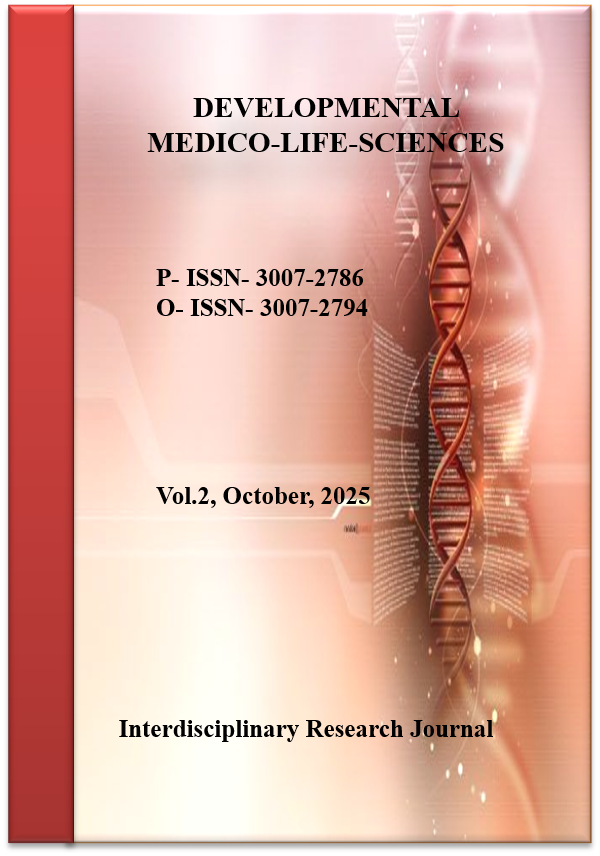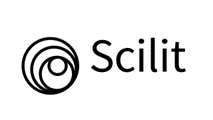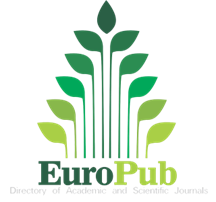Biochemical and Physiological Correlates of Non-Alcoholic Fatty Liver Disease (NAFLD): A Cross-Sectional Observational Study
Biochemical and Physiological Correlates of NAFLD
DOI:
https://doi.org/10.69750/dmls.02.09.0152Keywords:
NAFLD, insulin resistance, dyslipidemia, obesity, biochemical markers, inflammationAbstract
Background: Non-alcoholic fatty liver disease (NAFLD) has been categorized as one of the most prevalent chronic liver diseases globally, and many argue that it is the hepatic manifestation of metabolic syndrome. It is closely linked with obesity, dyslipidemia, insulin resistance, and hypertension. There is a need to determine its biochemical and physiological analogue to facilitate early diagnosis and risk stratification, particularly in developing countries such as Pakistan, where metabolic disorders associated with lifestyle are increasing at a very high pace.
Objective: The objective is to evaluate the biochemical and physiological indicators of NAFLD and establish their relationship with insulin resistance and hepatic dysfunction in adult participants.
Methods: This was a cross-sectional study that included observation of the Department of Medicine, Sheikh Zayed Medical Complex, Lahore, Pakistan, during the period between February 2024 and May 2025. Adults (100 and 30 NAFLD and healthy, respectively) diagnosed with NAFLD ultrasonographically and healthy control groups were used (100 and 30, respectively). Anthropometric indices, blood pressure, fasting glucose, lipid profile, liver enzymes, insulin, and high-sensitivity C-reactive protein (hs-CRP) were measured. Insulin resistance was measured by the HOMA-IR. The statistical analysis was provided by SPSS version 26, with p < 0.05 as a significant value.
Results: BMI (30.9 vs. 24.8 kg/m 2 ), fasting glucose (112.7 vs. 89.3 mg/dL), triglycerides (185.9 vs. 129.4 mg/dL), ALT (55.8 vs. 24.6 U/L), and HOMA-IR (4.1 vs. 2.1) were significantly different across the NAFLD patients. The positive correlation was found between ALT and triglycerides and HOMA-IR (r = 0.61 and 0.57, respectively), whereas the negative correlation was found between HDL-C and HOMA-IR (r = -0.46, p = 0.004).
Conclusion: NAFLD is narrowly interconnected with obesity, insulin resistance, dyslipidemia, and the increase of hepatic enzymes. These physiological and biochemical parameters would be monitored regularly to aid in the identification of NAFLD at an early stage and assess the risk, as well as prevent the disease in the at-risk population.
Downloads
References
Hu XY, Li Y, Li LQ, Zheng Y, Lv JH, Huang SC, et al. Risk factors and biomarkers of non-alcoholic fatty liver disease: an observational cross-sectional population survey. BMJ Open. 2018;8(4):e019974. doi:10.1136/bmjopen-2017-019974.
Chang WP, Chang YP. Correlation between component factors of non-alcoholic fatty liver disease and metabolic syndrome in nurses: an observational and cross-sectional study. Int J Environ Res Public Health. 2022;19:16294. doi:10.3390/ijerph192316294.
Reis SS, Callejas GH, Marques RA, et al. Correlation between anthropometric measurements and non-alcoholic fatty liver disease in individuals with obesity undergoing bariatric surgery: cross-sectional study. Obes Surg. 2021;31:3675–3685. doi:10.1007/s11695-021-05470-2.
Miyake T, Miyazaki M, Yoshida O, et al. Relationship between body composition and the histology of non-alcoholic fatty liver disease: a cross-sectional study. BMC Gastroenterol. 2021;21:170. doi:10.1186/s12876-021-01748-y.
Cong F, Zhu L, Deng L, et al. Correlation between nonalcoholic fatty liver disease and left ventricular diastolic dysfunction in non-obese adults: a cross-sectional study. BMC Gastroenterol. 2023;23:90. doi:10.1186/s12876-023-02708-4.
Wang YM, Zhu KF, Zhou WJ, et al. Sarcopenia is associated with the presence of nonalcoholic fatty liver disease in Zhejiang Province, China: a cross-sectional observational study. BMC Geriatr. 2021;21:55. doi:10.1186/s12877-020-01910-3.
Elshinshawy S, Elhaddad H, Abdel Alem S, Shaker O, Salam R, Yosry A, et al. The interrelation between hypothyroidism and non-alcoholic fatty liver disease: a cross-sectional study. J Clin Exp Hepatol. 2023;13(4):638–648. doi:10.1016/j.jceh.2023.03.004.
Zhang Y, Liu H. Cross-sectional association between prolactin levels and non-alcoholic fatty liver disease in patients with type 2 diabetes mellitus: a retrospective analysis from a single hospital in China. BMJ Open. 2022;12:e062252. doi:10.1136/bmjopen-2022-062252.
Xing Y, Cheng T, Zhou F, Ma H. Association between vitamin D and type 2 diabetes mellitus complicated with non-alcoholic fatty liver disease: an observational cross-sectional study. Diabetes Metab Syndr Obes. 2022;15:269–280. doi:10.2147/DMSO.S348870.
Sato S, Kamata Y, Kessoku T, et al. A cross-sectional study assessing the relationship between non-alcoholic fatty liver disease and periodontal disease. Sci Rep. 2022;12:13621. doi:10.1038/s41598-022-17917-2.
Yang B, Gong M, Zhu X, Luo Y, Li R, Meng H, et al. Correlation between liver fibrosis in non-alcoholic fatty liver disease and insulin resistance indicators: a cross-sectional study from NHANES 2017–2020. Front Endocrinol. 2025;16:1514093. doi:10.3389/fendo.2025.1514093.
Kim T, Choi H, Lee J, Kim J. Obstructive sleep apnea and nonalcoholic fatty liver disease in the general population: a cross-sectional study using nationally representative data. Int J Environ Res Public Health. 2022;19:8398. doi:10.3390/ijerph19148398.
Zhang J, Li K, Pan L, et al. Association of circulating adipsin with nonalcoholic fatty liver disease in obese adults: a cross-sectional study. BMC Gastroenterol. 2021;21:131. doi:10.1186/s12876-021-01721-9.
Borges-Canha M, Neves JS, Mendonça F, Silva MM, Costa C, Cabral PM, et al. Impact of vitamin D in non-alcoholic fatty liver disease: a cross-sectional study in patients with morbid obesity. Diabetes Metab Syndr Obes. 2021;14:487–495. doi:10.2147/DMSO.S286334.
Shih CI, Wu KT, Hsieh MH, et al. Severity of fatty liver is highly correlated with the risk of hypertension and diabetes: a cross-sectional and longitudinal cohort study. Hepatol Int. 2024;18:138–154. doi:10.1007/s12072-023-10576-z.
Mantovani A, Zusi C, Csermely A, et al. Association between lower plasma adiponectin levels and higher liver stiffness in type 2 diabetic individuals with nonalcoholic fatty liver disease: an observational cross-sectional study. Hormones (Athens). 2022;21:477–486. doi:10.1007/s42000-022-00387-6.
Hegazy MA, Elshafei A, Salem MR, Ashoush O, Abdelghani A. Non-alcoholic fatty liver disease–related knowledge among a sample of Egyptians: an exploratory cross-sectional study. Front Public Health. 2023;11:1290842. doi:10.3389/fpubh.2023.1290842.
Barros BSV, Monteiro FC, Terra C, et al. Prevalence of non-alcoholic fatty liver disease and its associated factors in individuals with type 1 diabetes: a cross-sectional study in a tertiary care center in Brazil. Diabetol Metab Syndr. 2021;13:33. doi:10.1186/s13098-021-00649-0.
Liu J, Tang Y, Feng Z, et al. Metabolic associated fatty liver disease and bone mineral density: a cross-sectional study of the National Health and Nutrition Examination Survey 2017–2018. Osteoporos Int. 2023;34:713–724. doi:10.1007/s00198-023-06687-w.
Jin B, Wu Z, Wang S, et al. Gender differences in non-alcoholic fatty liver disease in obese children and adolescents: a large cross-sectional study. Hepatol Int. 2024;18:179–187. doi:10.1007/s12072-023-10596-9.
Abenavoli L, Spagnuolo R, Scarlata GGM, Scarpellini E, Boccuto L, Luzza F. Ultrasound prevalence and clinical features of nonalcoholic fatty liver disease in patients with inflammatory bowel diseases: a real-life cross-sectional study. Medicina (Kaunas). 2023;59:1935. doi:10.3390/medicina59111935.
Peng H, Pan L, Ran S, Wang M, Huang S, Zhao M, et al. Prediction of MAFLD and NAFLD using different screening indexes: a cross-sectional study in U.S. adults. Front Endocrinol. 2023;14:1083032. doi:10.3389/fendo.2023.1083032.
Yu T, Zhou Y, Wu X, Fang Z, Liu C. Association between obstructive sleep apnea and non-alcoholic fatty liver disease: epidemiological cross-sectional study and Mendelian randomization analysis. Nat Sci Sleep. 2025;17:1361–1376. doi:10.2147/NSS.S524675.
Gu S, Hu S, Wang S, Qi C, Shi C, Fan G. Bidirectional association between NAFLD and gallstone disease: a systematic review and meta-analysis of observational studies. Expert Rev Gastroenterol Hepatol. 2023;17(3):283–293. doi:10.1080/17474124.2023.2175671.
Armandi A, Rosso C, Younes R, Leeming DJ, Karsdal MA, Caviglia GP, et al. Cross-sectional and longitudinal performance of non-invasive tests of liver fibrosis in patients with non-alcoholic fatty liver disease. J Clin Med. 2023;12:650. doi:10.3390/jcm12020650.






















